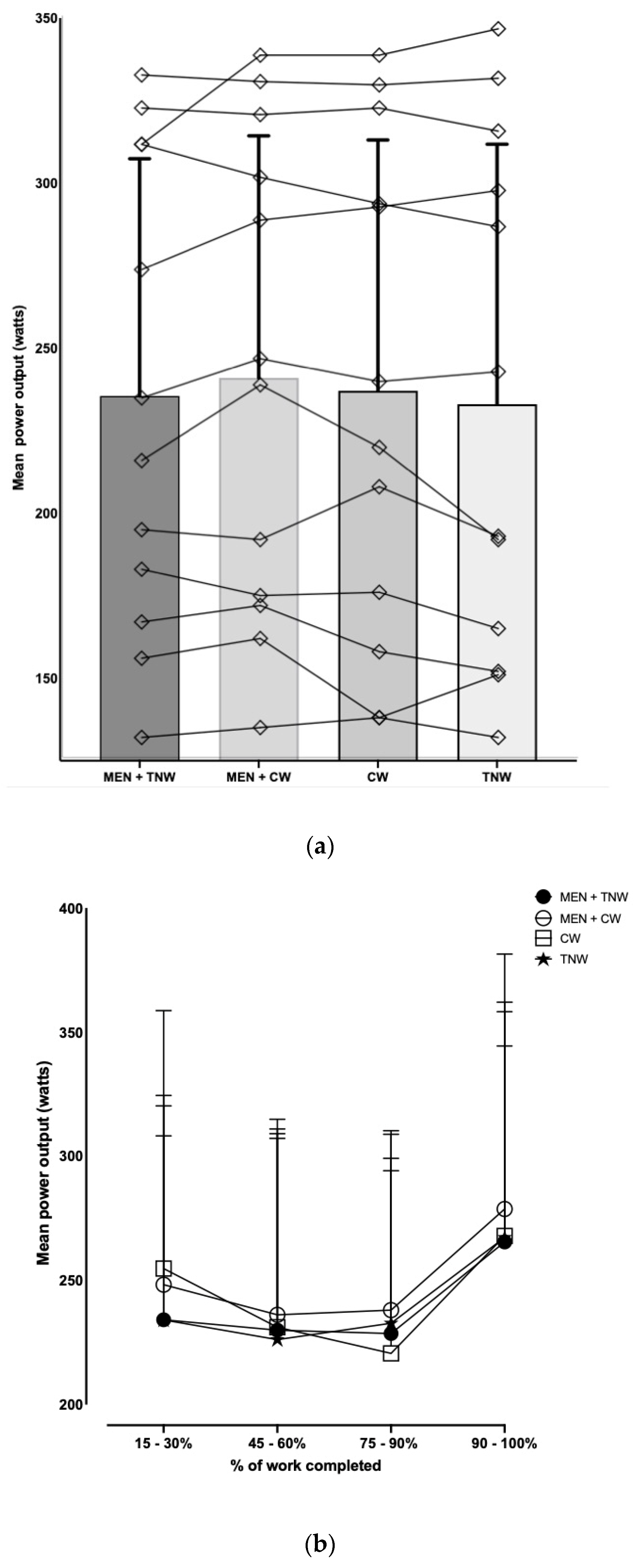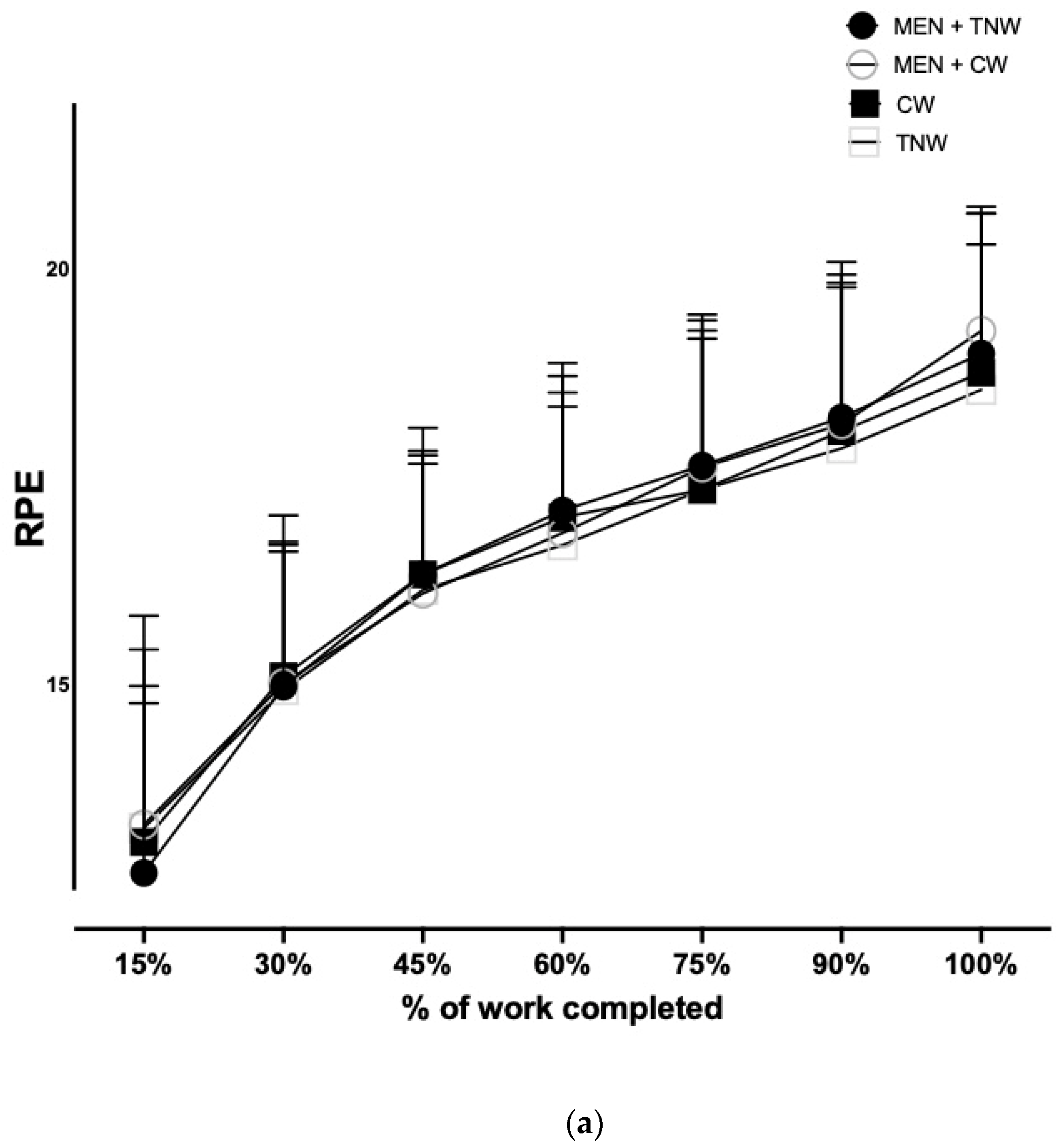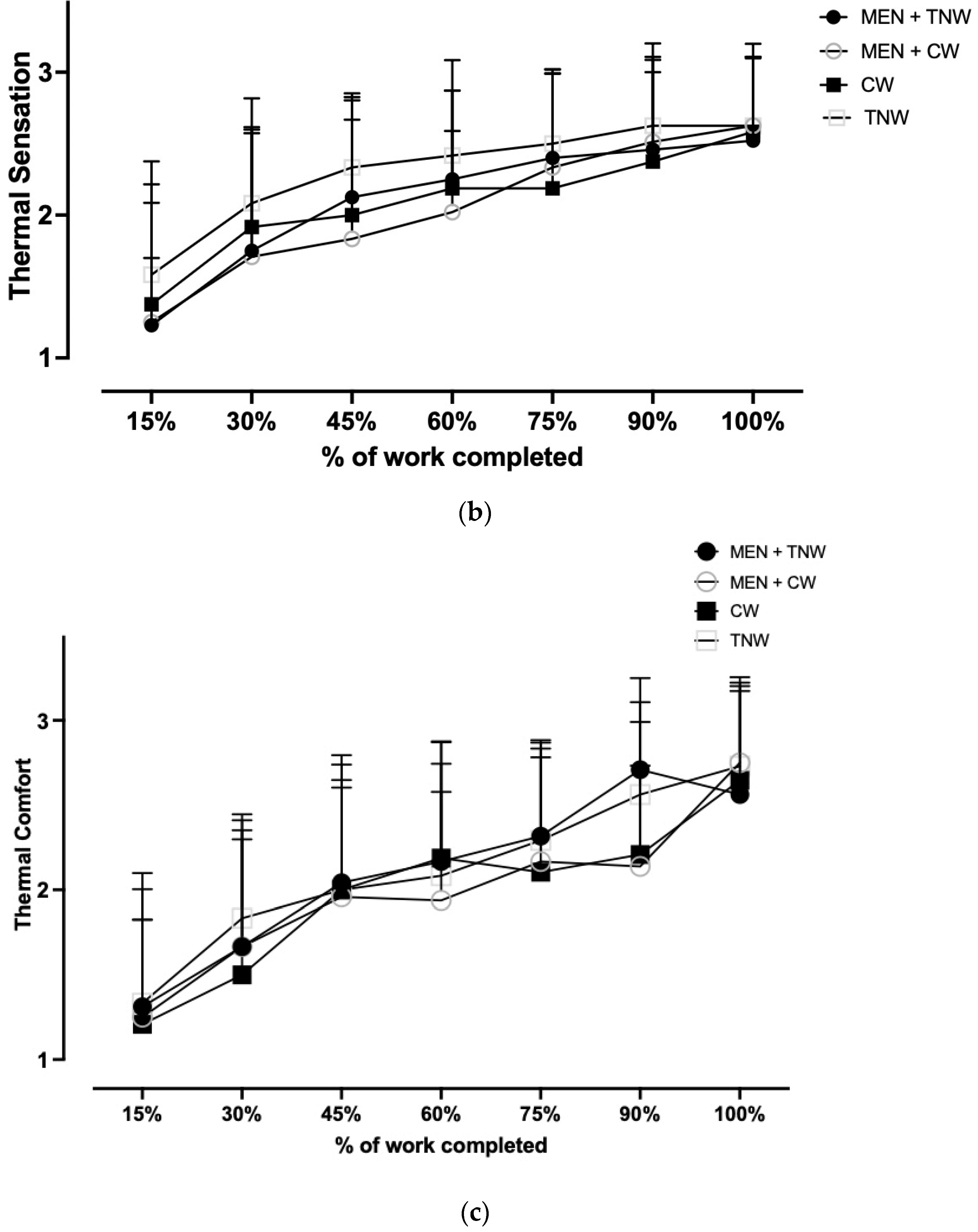The Effect of Menthol Mouth Rinsing and Fluid Temperature on Male Cycling Performance in Thermoneutral Conditions
Abstract
1. Introduction
2. Methods
2.1. Participants
2.2. Study Design
2.3. Preliminary Measurements—VO2 peak Determination
2.4. Familiarization and Experimental Protocol
2.5. Drink Formulation
2.6. Statistical Analysis
3. Results
3.1. Trial Conditions
3.2. Effect of MR on Cycling Time Trial Performance
3.3. Cardiovascular, Thermoregulatory, and Blood Lactate Response
3.4. Ratings of Perceived Exertion, Thermal Sensation, and Thermal Comfort
4. Discussion
4.1. Influence of Menthol Mouth Rinsing on Cycling Performance
4.2. Influence of MR and Fluid Temperature
4.3. Impact of Fluid Temperature on Menthol’s Effect
4.4. Limitations
5. Conclusions
Author Contributions
Funding
Institutional Review Board Statement
Informed Consent Statement
Data Availability Statement
Conflicts of Interest
Declaration of Interest Statement
References
- Eccles, R. Role of cold receptors and menthol in thirst, the drive to breathe and arousal. Appetite 2000, 34, 29–35. [Google Scholar] [CrossRef] [PubMed]
- Klasen, K.; Hollatz, D.; Zielke, S.; Gisselmann, G.; Hatt, H.; Wetzel, C.H. The TRPM8 ion channel comprises direct Gq protein-activating capacity. Pflugers Arch. 2012, 463, 779–797. [Google Scholar] [CrossRef]
- Guest, S.; Grabenhorst, F.; Essick, G.; Chen, Y.; Young, M.; McGlone, F.; de Araujo, I.; Rolls, E.T. Human cortical representation of oral temperature. Physiol. Behav. 2007, 92, 975–984. [Google Scholar] [CrossRef] [PubMed]
- Mundel, T.; Jones, D.A. The effects of swilling an L(−)-menthol solution during exercise in the heat. Eur. J. Appl. Physiol. 2010, 109, 59–65. [Google Scholar] [CrossRef] [PubMed]
- Stevens, C.J.; Best, R. Menthol: A Fresh Ergogenic Aid for Athletic Performance. Sports Med. 2017, 47, 1035–1042. [Google Scholar] [CrossRef] [PubMed]
- Jeffries, O.; Waldron, M. The effects of menthol on exercise performance and thermal sensation: A meta-analysis. J. Sci. Med. Sport 2019, 22, 707–715. [Google Scholar] [CrossRef] [PubMed]
- Gavel, E.H.; Hawke, K.V.; Bentley, D.J.; Logan-Sprenger, H.M. Menthol Mouth Rinsing Is More Than Just a Mouth Wash-Swilling of Menthol to Improve Physiological Performance. Front. Nutr. 2021, 8, 691695. [Google Scholar] [CrossRef] [PubMed]
- Gavel, E.H.; Barreto, G.; Hawke, K.V.; Stellingwerff, T.; James, L.J.; Saunders, B.; Logan-Sprenger, H.M. How Cool is That? The Effects of Menthol Mouth Rinsing on Exercise Capacity and Performance: A Systematic Review and Meta-analysis. Sports Med. Open 2024, 10, 18. [Google Scholar] [CrossRef] [PubMed]
- Parton, A.J.; Waldron, M.; Clifford, T.; Jeffries, O. Thermo-behavioural responses to orally applied l-menthol exhibit sex-specific differences during exercise in a hot environment. Physiol Behav. 2021, 229, 113250. [Google Scholar] [CrossRef] [PubMed]
- Saldaris, J.M.; Landers, G.J.; Lay, B.S. Physical and perceptual cooling: Improving cognitive function, mood disturbance and time to fatigue in the heat. Scand J. Med. Sci. Sports 2020, 30, 801–811. [Google Scholar] [CrossRef]
- Gavel, E.H.; Logan-Sprenger, H.M.; Good, J.; Jacobs, I.; Thomas, S.G. Menthol Mouth Rinsing and Cycling Performance in Females Under Heat Stress. Int. J. Sports Physiol. Perform. 2021, 16, 1014–1020. [Google Scholar] [CrossRef] [PubMed]
- Miranda Neto, M.; da Silva, R.S.B.; Silva, A.S. Influence of the administration form of menthol in physical performance in endurance exercise: A systematic review. Sci. Sports 2023, 38, 663–675. [Google Scholar] [CrossRef]
- Schlader, Z.J.; Simmons, S.E.; Stannard, S.R.; Mundel, T. The independent roles of temperature and thermal perception in the control of human thermoregulatory behavior. Physiol. Behav. 2011, 103, 217–224. [Google Scholar] [CrossRef] [PubMed]
- Schlader, Z.J. The human thermoneutral and thermal comfort zones: Thermal comfort in your own skin blood flow. Temperature 2014, 2, 47–48. [Google Scholar] [CrossRef] [PubMed]
- Best, R.; Temm, D.; Hucker, H.; McDonald, K. Repeated menthol mouth swilling affects neither strength nor power performance. Sports 2020, 8, 90. [Google Scholar] [CrossRef] [PubMed]
- Tran Trong, T.; Riera, F.; Rinaldi, K.; Briki, W.; Hue, O. Ingestion of a cold temperature/menthol beverage increases outdoor exercise performance in a hot, humid environment. PLoS ONE 2015, 10, e0123815. [Google Scholar] [CrossRef] [PubMed]
- Flood, T.R.; Waldron, M.; Jeffries, O. Oral L-menthol reduces thermal sensation, increases work-rate and extends time to exhaustion, in the heat at a fixed rating of perceived exertion. Eur. J. Appl. Physiol. 2017, 117, 1501–1512. [Google Scholar] [CrossRef] [PubMed]
- Gibson, O.R.; Wrightson, J.G.; Hayes, M. Intermittent sprint performance in the heat is not altered by augmenting thermal perception via L-menthol or capsaicin mouth rinses. Eur. J. Appl. Physiol. 2019, 119, 653–664. [Google Scholar] [CrossRef]
- Jeffries, O.; Goldsmith, M.; Waldron, M. L-Menthol mouth rinse or ice slurry ingestion during the latter stages of exercise in the heat provide a novel stimulus to enhance performance despite elevation in mean body temperature. Eur. J. Appl. Physiol. 2018, 118, 2435–2442. [Google Scholar] [CrossRef] [PubMed]
- Borg, G.A. Psychophysical bases of perceived exertion. Med. Sci. Sports Exerc. 1982, 14, 377–381. [Google Scholar] [CrossRef]
- Zuniga, J.M.; Housh, T.J.; Camic, C.L.; Bergstrom, H.C.; Traylor, D.A.; Schmidt, R.J.; Johnson, G.O. Metabolic parameters for ramp versus step incremental cycle ergometer tests. Appl. Physiol. Nutr. Metab. 2012, 37, 1110–1117. [Google Scholar] [CrossRef] [PubMed]
- Logan-Sprenger, H.M.; Heigenhauser, G.J.; Jones, G.L.; Spriet, L.L. The effect of dehydration on muscle metabolism and time trial performance during prolonged cycling in males. Physiol. Rep. 2015, 3, e12483. [Google Scholar] [CrossRef] [PubMed]
- Logan-Sprenger, H.M.; Heigenhauser, G.J.; Killian, K.J.; Spriet, L.L. Effects of dehydration during cycling on skeletal muscle metabolism in females. Med. Sci. Sports Exerc. 2012, 44, 1949–1957. [Google Scholar] [CrossRef] [PubMed]
- Casa, D.J. Exercise in the heat. I. Fundamentals of thermal physiology, performance implications, and dehydration. J. Athl. Train 1999, 34, 246–252. [Google Scholar] [PubMed]
- Gagge, A.P.; Stolwijk, J.A.; Hardy, J.D. Comfort and thermal sensations and associated physiological responses at various ambient temperatures. Environ. Res. 1967, 1, 1–20. [Google Scholar] [CrossRef] [PubMed]
- Bedford, T. The Warmth Factor in Comfort at Work: A Physiological Study of Heating and Ventilation; Industrial Health Research Board No 76; HMSO: London, UK, 1936. [Google Scholar]
- Verdel, N.; Podlogar, T.; Ciuha, U.; Holmberg, H.C.; Debevec, T.; Supej, M. Reliability and Validity of the CORE Sensor to Assess Core Body Temperature during Cycling Exercise. Sensors 2021, 21, 5932. [Google Scholar] [CrossRef] [PubMed]
- Crosby, S.; Butcher, A.; McDonald, K.; Berger, N.; Bekker, P.J.; Best, R. Menthol mouth rinsing maintains relative power production during three-minute maximal cycling performance in the heat compared to cold water and placebo rinsing. J. Environ. Public Health 2022, 19, 3527. [Google Scholar] [CrossRef] [PubMed]
- Jerram, M.L.; Baker, D.; Smith, T.B.; Healey, P.; Taylor, L.; Black, K. A 0.1% L-Menthol mouth swill in elite male rugby players has different effects in forwards and backs. Int. J. Sports Physiol. Perform. 2023, 909, 1–9. [Google Scholar] [CrossRef] [PubMed]
- Riera, F.; Trong, T.T.; Sinnapah, S.; Hue, O. Physical and perceptual cooling with beverages to increase cycle performance in a tropical climate. PLoS ONE 2014, 9, e103718. [Google Scholar] [CrossRef] [PubMed]
- Best, R.; McDonald, K.; Hurst, P.; Pickering, C. Can taste be ergogenic? Eur. J. Nutr. 2021, 60, 45–54. [Google Scholar] [CrossRef] [PubMed]




| MEN + TNW | MEN + CW | CW | TNW | |
|---|---|---|---|---|
| TT duration (mins:sec) | 38:11 ± 12:48 | 37:21 ± 13:00 | 38:12 ± 13:54 | 39:06 ± 14:12 |
| Mean TT PO (W) | 236 ± 72 | 241 ± 73 | 237 ± 76 | 233 ± 79 |
| 15–30% PO (W) | 234 ± 74 | 248 ± 76 | 255 ± 104 | 234 ± 86 |
| 45–60% PO (W) | 230 ± 77 | 236 ± 73 | 231 ± 80 | 226 ± 89 |
| 75–90% PO (W) | 229 ± 71 | 238 ± 72 | 221 ± 74 | 233 ± 76 |
| 90–100% PO (W) | 266 ± 79 | 279 ± 103 | 268 ± 94 | 267 ± 91 |
| Variable | Swill | Comparator | Hedge’s g | 95% CI |
|---|---|---|---|---|
| Mean time trial (secs) | MEN + TNW | MEN + CW | g = 0.36 | −36.69 to 141.0 |
| MEN + TNW | CW | g = 0.05 | −166.0 to 149.3 | |
| MEN + TNW | TNW | g = 0.4 | −214.2 to 90.04 | |
| MEN + CW | CW | g = 0.4 | −225.9 to 104.9 | |
| MEN + CW | TNW | g = 0.74 | −256.4 to 27.9 | |
| CW | TNW | g = 0.34 | −197.9 to 90.41 | |
| Mean power output (Watts) | MEN + TNW | MEN + CW | g = 0.4 | −15.7 to 4.7 |
| MEN + TNW | CW | g = 0.11 | −13.57 to 10.4 | |
| MEN + TNW | TNW | g = 0.18 | −13.3 to 18.3 | |
| MEN + CW | CW | g = 0.28 | −5.7 to 13.5 | |
| MEN + CW | TNW | g = 0.57 | −5.1 to 21.1 | |
| CW | TNW | g = 0.28 | −5.6 to 13.8 |
| MEN + TNW | MEN + CW | CW | TNW | |
|---|---|---|---|---|
| Heart Rate (bpm) | 175 ± 13 | 175 ± 5 | 177 ± 14 | 172 ± 14 |
| Sweat Loss (L) | 0.8 ± 0.2 | 0.9 ± 0.4 | 1.0 ± 0.3 | 1.0 ± 0.5 |
| Mean Tc (°C) | 37.8 ± 0.3 | 37.6 ± 0.3 | 37.8 ± 0.5 | 37.8 ± 0.4 |
| △[BLa] (mmol·L−1) | 9.2 ± 3.3 | 8.7 ± 4.2 | 8.3 ± 3.4 | 7.6 ± 2.0 |
| Variable | Swill | Comparator | Hedge’s g | 95% CI |
|---|---|---|---|---|
| RPE | MEN + TNW | MEN + CW | g = 0.18 | −1.8 to 1.7 |
| MEN + TNW | CW | g = 0.14 | −1.7 to 1.7 | |
| MEN + TNW | TNW | g = 0.55 | −1.5 to 1.9 | |
| MEN + CW | CW | g = 0.32 | −1.6 to 1.8 | |
| MEN + CW | TNW | g = 0.73 | −1.5 to 1.9 | |
| CW | TNW | g = 0.42 | −1.6 to 1.8 | |
| Thermal Sensation | MEN + TNW | MEN + CW | g = 0.55 | −0.6 to 0.7 |
| MEN + TNW | CW | g = 0.14 | −0.6 to 0.6 | |
| MEN + TNW | TNW | g = 2.39 | −0.8 to 0.4 | |
| MEN + CW | CW | g = 0.39 | −0.7 to 0.6 | |
| MEN + CW | TNW | g = 2.64 | −0.9 to 0.4 | |
| CW | TNW | g = 2.19 | −0.8 to 0.4 | |
| Thermal Comfort | MEN + TNW | MEN + CW | g = 1.29 | −0.5 to 0.7 |
| MEN + TNW | CW | g = 1.22 | −0.5 to 0.7 | |
| MEN + TNW | TNW | g = 0.09 | −0.6 to 0.6 | |
| MEN + CW | CW | g = 0.02 | −0.6 to 0.6 | |
| MEN + CW | TNW | g = 1.37 | −0.7 to 0.5 | |
| CW | TNW | g = 1.29 | −0.7 to 0.5 |
Disclaimer/Publisher’s Note: The statements, opinions and data contained in all publications are solely those of the individual author(s) and contributor(s) and not of MDPI and/or the editor(s). MDPI and/or the editor(s) disclaim responsibility for any injury to people or property resulting from any ideas, methods, instructions or products referred to in the content. |
© 2024 by the authors. Licensee MDPI, Basel, Switzerland. This article is an open access article distributed under the terms and conditions of the Creative Commons Attribution (CC BY) license (https://creativecommons.org/licenses/by/4.0/).
Share and Cite
Gavel, E.H.; Hawke, K.V.; Logan-Sprenger, H.M. The Effect of Menthol Mouth Rinsing and Fluid Temperature on Male Cycling Performance in Thermoneutral Conditions. Nutrients 2024, 16, 1016. https://doi.org/10.3390/nu16071016
Gavel EH, Hawke KV, Logan-Sprenger HM. The Effect of Menthol Mouth Rinsing and Fluid Temperature on Male Cycling Performance in Thermoneutral Conditions. Nutrients. 2024; 16(7):1016. https://doi.org/10.3390/nu16071016
Chicago/Turabian StyleGavel, Erica H., Kierstyn V. Hawke, and Heather M. Logan-Sprenger. 2024. "The Effect of Menthol Mouth Rinsing and Fluid Temperature on Male Cycling Performance in Thermoneutral Conditions" Nutrients 16, no. 7: 1016. https://doi.org/10.3390/nu16071016
APA StyleGavel, E. H., Hawke, K. V., & Logan-Sprenger, H. M. (2024). The Effect of Menthol Mouth Rinsing and Fluid Temperature on Male Cycling Performance in Thermoneutral Conditions. Nutrients, 16(7), 1016. https://doi.org/10.3390/nu16071016






